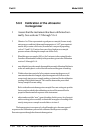
1-42 Part III
Part III Model 6600
Teledyne Analytical Instruments
The reference and measuring signal at the first stage of integration can be
observed by placing the scope probe across capacitors C4 and C5 respectively
located at PC Board 1 in the detector unit. A dual trace scope is advantageous
but not required for this observation.
The test points’ significance is that they reveal proper switch action. The
display shows a sawtooth pattern which is a charge-discharge of the first
capacitor in the integrating network. This ripple is the AC component of the
reference and measuring signal after the pulses are converted to DC. The
sawtooth patterns must be displayed 180 with respect to each other as viewed
with a dual trace scope. They must be both present.
If one is missing, this means that the switch is not switching.
If the sawtooth shows a broken pattern, this means the switching action is
feeble or irregular.
The faulty condition of the switch can usually be corrected by moving the
switch up and down or rotating it in its holder.
The magnetic mercury reed switch is activated by the action of a bar magnet
and a rotating chopper disc.
An aluminum motor mounting block houses a bar magnet. This bar magnet
is positioned in parallel with the mercury chopper switch.
The chopper disc is the green and black disc mounted on the filter wheel
shaft next to the motor. The disc is composed of both magnetic and nonmagnetic
materials.
As the shaft rotates, the magnetic portion of the disc shorts the magnetic
flux as it passes between the magnet and the switch. The nonmagnetic portion
of the disc will allow flux lines from the bar magnet to activate the mercury
switch.
7.6 Sample Cell Maintenance
The Sample Cell needs inspection every 6 weeks. For E.P. systems, open
the sample compartment and inspect the cell windows for dirt and oil film. This
inspection can be quickly done by removing the external folded optyical path
assembly from the main Control/Analysis Unit. Disassemble all, clean and
reassemble exactly as before. Re-zero and span calibrate the unit preferably with
zero prepared water and span fluids. Thereafter, recheck span flow as appli-
cable. Reset span flag valu to new calibration values as performed during startup
procedure.
CAUTION: wear UV goggles if lamp left on.


















